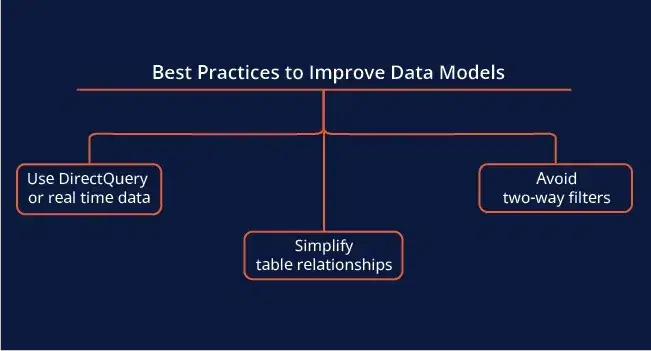Introduction:
Why Power BI Is Important in Healthcare?
Top Power BI Practices to Improve Patient Care and Team Performance
1. Create a Perfect Data Model for Patient Records:

- Use DirectQuery for real time data: Get real-time updates on patient important treatment responses by using directQuery. This helps the medical team respond faster.
- Simplify table relationships: Keep relationships between data tables simple. It reduces complications and speeds up data processing.
- Avoid two-way filters: Only use one-way filters to avoid performance problems and make your reports load faster.
2. Make DAX More Efficient for Better Analysis of Medical Data:
- Use SUMX for Large Data Sets: Summarize patient statistics or performance numbers more easily with SUMX.
- Minimize DISTINCT Usage: Avoid using DISTINCT functions as they can slow down report generation.
- Stop Unnecessary Calculations: This can save time, making it easier to focus on critical patient data.
3. Make Healthcare Data Visual for Better Decision-Making:

- Pick the Right Visuals: Use appropriate visuals like line charts to track patient progress or bar charts for staff performance comparison.
- Limit the Number of Visuals: Too many visuals can slow down the Power BI dashboards. Keep it simple to assure quick load times.
- Avoid Overloading Data: Avoid using unclear visuals, which can make reports harder to read. Always opt for clear and separate visuals for each data point.
4. Control Data Refresh for Better Operations:
- Use Incremental Refresh: Update only new or changed patient data to avoid unnecessary refresh rates.
- Improve Queries: Streamline your queries to reduce the load on servers, which improves the overall performance of Power BI reporting.
- Use Caching: Cache frequently uses queries to reduce processing time and improve the speed of dashboards.
5. Keep Data Safe in Power BI:

- Role-Based Access Control: Assign specific roles to team members so that only authorized personnel can view sensitive data like patient health records.
- Data Encryption: Make sure all patient data is encrypted, especially when it’s being transmitted across platforms.
- Limit Access Based on Conditions: Restrict access based on the user’s role, device, or location to enhance data security.















